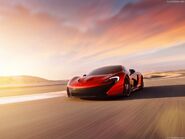The McLaren P1 is a limited production plug-in hybrid hypercar by British automotive manufacturer McLaren.

| |
| McLaren P1 | |
|---|---|
| McLaren | |
| aka | The Widow Maker |
| Production | October 2013- 10 December 2015
(381 units, including 6 LM) |
| Class | Hypercar |
| Body Style | 2-door coupé |
| Length | 4588 mm |
| Width | 1946 mm |
| Height | 1188 mm |
| Wheelbase | 2670 mm |
| Weight | 1,547 kg (3,411 lb) |
| Transmission | 7-speed dual-clutch |
| Engine | 3.8 L twin-turbo M838TQ V8 |
| Power | 916 PS (903 bhp) (673 kW) |
| Similar | McLaren 12C |
| Designer | Frank Stephenson |
Automotive. The concept car debuted at the 2012 Paris Motor Show. Deliveries to retail customers began in the UK in October 2013. The entire P1 production of 375 units was sold out by November 2013. The production run ended in December 2015. The United States accounted for 34% of the limited production run, and Europe for 26%.
It is considered to be the long-awaited successor to the McLaren F1, utilizing hybrid power and Formula 1 technology. It does not have the same three seat layout as its predecessor. The design of the headlights is very similar to the shape of the McLaren logo. Just like the McLaren F1 road car of 1992, the McLaren P1 is a mid-engine, rear-wheel drive design that uses a carbon fibre monocoque and roof structure safety cage concept called MonoCage, which is a development of the MonoCell used in the current MP4-12C and MP4-12C Spider upgrade that came out in early 2012.
A track-only version of the P1, the McLaren P1 GTR, was unveiled at the 2015 Geneva Motor Show. Production of the GTR will be limited to 35 units and only the 375 McLaren P1 owners will be invited to buy one. The P1 GTR is more powerful, with better brakes than the 916 PS (903 bhp, 673 kW) normal McLaren P1 hypercar.
Specifications
The P1 features a 3.8-litre twin-turbocharged V8 petrol engine that is only similar to the mj 200 engine in its displacement. The twin turbos boost the petrol engine at 2.4 bar to deliver 727 bhp (737 PS, 542 kW) and 531 lb ft (719 Nm) of torque at 7500 rpm, combined with an in-house developed electric motor producing 179 PS (176 bhp, 131 kW) and 192 lb ft (260 Nm). With both engine and the electric motor, the P1 will have a total power and torque output of 903 bhp (916 PS, 673 kW) and 722 lb ft (978 Nm) of torque respectively. The electric motor can be deployed manually by the driver or left in automatic mode, whereby the car's ECUs 'torque fill' the gaps in the petrol engine's output, which is considered turbo lag. This gives the powertrain an effective powerband of almost 7000rpm. The car is rear-wheel drive with a seven-speed dual-clutch transmission by Graziano.
Power for the electric motor is stored in a 324-cell lithium-ion high density battery packlocated behind the cabin, developed by Johnson Matthey Battery Systems. The battery can be charged by the engine or through a plug-in equipment and can be fully charged in two hours. The car can be operated using either the petrol engine, the electric motor or with a combination of the two. The P1 has an all-electric range of at least 10 km (6.2 mi) on the combined European drive cycle. Under the EPA cycle, the range in EV mode is 19 mi (31 km). During EV mode the P1 has a gasoline consumption of 4.8 gallons per 100 mi, and as a result, EPA's all-electric range is rated as zero. The total range is 330 mi (530 km). The P1 combined fuel economy in EV mode was rated by the EPA at 18 miles per gallon gasoline equivalent (MPG-equivalent) (13 L gasoline equivalent/100 km; 22 mpg-imp gasoline equivalent), with an energy consumption of 25 kW-hrs/100 mi and gasoline consumption of 4.8 gal-US/100 mi. The combined fuel economy when running only with gasoline is 17 mpg-US (14 L/100 km; 20 mpg-imp), 16 mpg-US (15 L/100 km; 19 mpg-imp) for city driving, and 20 mpg-US (12 L/100 km; 24 mpg-imp) in highway.
The P1 comes with Formula 1 derived features such as the Instant Power Assist System (IPAS), which will give an instant boost in acceleration via the electric motor, a Drag Reduction System (DRS) which operates the car's rear wing, thereby increasing straight line speed, and a KERS. Both of these features (IPAS, DRS) are operated via two buttons on the steering wheel.
The P1 will accelerate from 0 to 100 km/h (62 mph) in 2.8 seconds, 0 to 200 km/h (124 mph) in 6.8 seconds, and 0 to 300 km/h (186 mph) in 16.5 seconds, making it a full 5.5 seconds faster than the McLaren F1. It completes a standing quarter mile in 9.8 seconds at 245 km/h (152 mph). The Mclaren P1 is capable of reaching a top speed of 395 km/h (245 mph) but it is electronically limited to a top speed of 349 km/h (217 mph) . The P1 has a dry weight of 1,395 kg (3,075 lb), giving it a power-to-weight ratio of 647 bhp/tonne. It has a kerb weight of 1,547 kg (3,411 lb) which translates to of 593 bhp/ tonne. Actual kerb weight (full tank of gas, no luggage or people) of US-spec vehicles is 3411 lb. The P1 also features bespoke Pirelli P-Zero Corsa tyres and specially developed carbon-ceramic brakes from Akebono. It takes 6.2 seconds to brake from 299 km/h (186 mph) to standstill, during which it will cover 246 metres. From 97 km/h (60 mph), it will cover 30.2 metres.
Production and sales
The production version of the McLaren P1 was unveiled at the 2013 Geneva Motor Show. Production was strictly limited to 375 units which, according to McLaren, is to maintain exclusivity. Pricing started at £866,000(€1,030,000 or US$1,350,000) but, as of November 2013, about 75% of P1 customers have opted for some level of unique design from McLaren Special Operations, raising the average sale price of a P1 above £1 million(€1.2 million or US$1.6 million).
In August 2013 McLaren announced that the production allocation destined to the Americas, Asia-Pacific and the Middle East was sold out. The cars destined for Europe were sold out by mid November 2013. The United States accounted for 34% of the limited production run, and Europe for 26%.
After some delays, production began in October 2013. Hand-assembled by a select team of 61 engineers, at a production rate of 1 car per day McLaren expected to build 50 P1s by the end of 2013. The first delivery to a retail customer took place at the company's headquarters in Woking, England, in October 2013, with 12 units manufactured by mid November 2013. The first P1 delivery in the U.S. occurred in May 2014. The production run ended in December 2015.
According to JATO Dynamics, only 20 units have been registered worldwide during the first nine months of 2014. A total of 12 P1s were registered in Switzerland during 2014, and an additional 5 units between January and August 2015. About 59 units were delivered in the U.S. in 2014, and sales in the American market totaled about 127 units delivered through December 2015.
Variants
P1 GTR

McLaren P1 GTR at the 2015 Geneva Motor Show
Celebrating 20 years since their victory in the 1995 24 Hours of Le Mans, McLaren announced that they would resurrect the GTR name by launching a track-only version of the P1, the McLaren P1 GTR. The GTR will be made available to the 375 McLaren P1 owners only, and will be a very limited edition of 35 units. The concept car made its debut at the 2014 Pebble Beach Concours d'Elegance in August 2014. The P1 GTR production model was officially unveiled at the 2015 Geneva Motor Show. The GTR variant is priced at £1.9 million. McLaren states that this will be the most powerful McLaren to date, with an intended power output of 1,000 PS (987 bhp, 735 kW). The car will also feature slick tyres, and is claimed to have greater levels of performance, grip, aerodynamics and downforce in comparison to the road car. Featuring a new fixed ride height on race-prepared suspension, a fixed rear wing capable of using DRS, and a new exclusively designed exhaust, McLaren aims to deliver the ultimate track experience. This limited edition will go into production in 2015, after all 375 standard McLaren P1's have been built, as homage to its race-winning ancestor, the iconic F1 GTR, and will be built, maintained and run by McLaren Special Operations. The McLaren P1 GTR hybrid engine aims at producing 1,000 PS (987 bhp); 84 bhp over the current model, although McLaren did not disclose whether the power increase is from electrical boost or tuning the twin turbo 3.8-litre V8. Performance figures are unconfirmed. P1 GTR weight was reduced by 50 kg and deliver power-to-weight ratio of 687 bhp per tonne. The P1 GTR can accelerate from 0-60 mph in just 2.4 seconds, with the top speed at 362 km/h (225 mph), which is actually slower than the 395 km/h normal P1 without the limiter. It brakes from 97 km/h to 0 in less than 26 metres, and corners at 1.54 G.
P1 LM
Owners of P1 GTRs were able to convert their cars to a road-legal status through aftermarket developments made by Lanzante Motorsport. Prompted by Lanzante's efforts, McLaren authorized the construction of five brand new cars (plus one prototype) to a specification identical to the converted GTRs, with Lanzante constructing the cars. These six LM specification cars remove the pneumatic jack system of the GTR to save weight, and the addition of lighter seats, titanium bolts, and Lexan windows. Engine output remains identical to the GTR, although modifications were made to the cooling systems. The rear wing and front splitter have also been redesigned to produce additional downforce over the GTR's aerodynamics.
Media
McLaren announced a sub-seven minute lap of the Nürburgring Nordschleife, which equates to an average speed in excess of 179 km/h (111 mph), but did not publish the exact time. The P1 currently holds the production car lap record at Circuit of the Americas, Algarve International Circuit, Anglesey Coastal Circuit and Silverstone National Circuit.
Trivia
- The McLaren P1 was Jeremy Clarkson's 2013 Car of the Year.
Gallery
P1 Concept
P1

|
This page uses some content from Wikipedia. The original article was at McLaren P1. The list of authors can be seen in the page history. As with Autopedia, the text of Wikipedia is available under the GNU Free Documentation License. |
| McLAREN | ||
|
Mercedes-Benz | Maybach | Smart | Mitsubishi | GEM | Mercedes-AMG | Freightliner | Mitsubishi Fuso Truck and Bus Corporation | OriOn | Setra | Sterling Trucks | Thomas Built Buses | Western Star | McLaren Group Ultimate Series F1 · Senna · Elva · P1 · Speedtail · Solus GT Super Series Sports Series Other GT · SLR · SLR Roadster · SLR Stirling Moss McLaren F1 Variants Racing M2B · M4B · M5A · M7A · M14A · M19A· M23 · M26 · M28 · M29 · M30 · MP4/1 · MP4/2 · MP3/3 · MP4/4 · MP4/5 · MP4/6 · MP4/7A · MP4/8 · MP4/9 · MP4/10 · MP4/11 · MP4/12 · MP4-13 · MP4/14 · MP4/15 · MP4-16 · MP4-17 · MP4-18 · MP4-19 · MP4-20 · MP4-21 · MP4-22 · MP4-23 · MP4-24 · MP4-25 · MP4-26 · MP4-27 · MP4-28 · MP4-29 · MP4-30 · MP4-31 · MCL32 · MCL33 · MCL34 · MCL35 · MCL36 · MP4-12C GT3 · 650S GT3 Bruce McLaren · Ron Dennis · Gordon Murray · Peter Stevens · McLaren Technology Centre | ||
| Ron Dennis | Corporate website | independent |


























































































